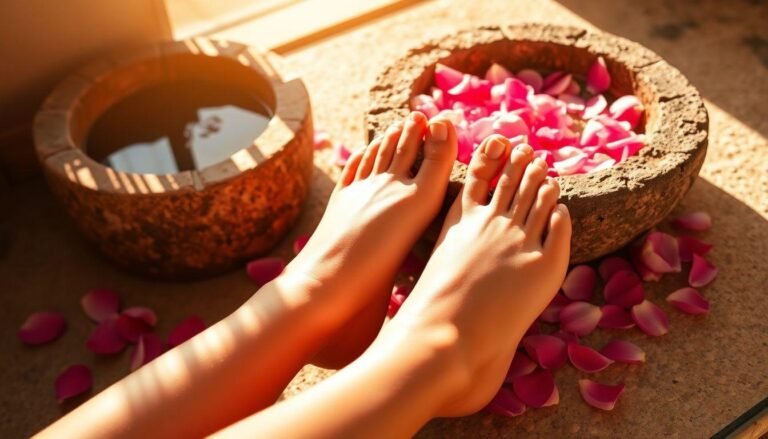Our feet carry us through life’s journey, yet they often receive the least attention in our skincare routines. From daily walks to standing for hours, our feet endure considerable stress that can leave them dry, rough, and callused. Creating a dedicated feet skin care routine isn’t just about aesthetics—it’s about comfort and health too. When your feet feel good, you feel good! Let’s explore some effective ways to transform those tired soles into smooth, soft feet you’ll be proud to show off in your favorite sandals.
Why Foot Care Matters More Than You Think
Our feet contain thousands of sweat glands and bear the weight of our entire body each day. This constant pressure, combined with friction from shoes and environmental factors, makes them prone to dryness and cracking. Beyond the cosmetic benefits, proper foot care helps prevent painful conditions like cracked heels, fungal infections, and even more serious complications for those with diabetes or circulation issues.
Regular foot maintenance isn’t vanity—it’s preventative healthcare that contributes to your overall well-being and mobility. Plus, who doesn’t love the confidence boost that comes with having beautifully maintained feet?
Daily Foot Care Essentials
Cleansing: The Foundation of Healthy Feet
Start with thorough cleansing. Wash your feet daily with warm water and a gentle soap, making sure to clean between your toes where moisture and bacteria love to hide. This simple step removes dirt, sweat, and bacteria that contribute to odor and potential infections.
For an extra refreshing cleanse, try adding a few drops of tea tree or peppermint essential oil to your foot bath. These natural ingredients provide antimicrobial benefits and leave your feet feeling tingly and revitalized.
Exfoliation: Saying Goodbye to Rough Skin
Exfoliation is crucial for removing dead skin cells that contribute to roughness. Use a foot scrub or pumice stone 2-3 times weekly, focusing on callused areas like heels and the balls of your feet. The key is consistency without overdoing it—aggressive scrubbing can damage skin and create more problems.
Try this easy DIY foot scrub:
Mix all ingredients and massage onto damp feet in circular motions before rinsing. Your feet will thank you!
Hydration: The Secret to Lasting Softness
After cleansing and exfoliating, immediately apply a rich moisturizer to lock in hydration. Look for foot creams containing ingredients like:
For intensive treatment, apply a generous layer of moisturizer before bed and wear cotton socks overnight. This “moisture sandwich” method allows the product to penetrate deeply while you sleep.
Weekly Treatments for Extra Care
Foot Soaks: Therapeutic and Relaxing
Once a week, treat yourself to a luxurious foot soak. Fill a basin with warm water and add one of these beneficial ingredients:
Soak for 15-20 minutes, then follow with exfoliation and moisturizing for maximum benefits. It’s like a mini spa day for your feet!
DIY Foot Masks: Intensive Hydration
For severely dry feet, try this intensive hydrating mask:
Mix ingredients into a paste, apply to clean feet, and wrap with plastic wrap. Put on socks and leave for 30 minutes before rinsing. The natural enzymes and oils will transform rough skin into baby-soft soles.
Addressing Common Foot Issues
Cracked Heels: Healing and Prevention
Cracked heels can be painful and unsightly. For healing:
Prevention is equally important—regular maintenance keeps small issues from becoming painful problems.
Calluses: When to Treat and When to Seek Help
Some calluses protect your feet and should be maintained rather than removed entirely. However, when they become thick or painful, gentle reduction is needed. Use a foot file after soaking when skin is soft, and always file in one direction rather than back and forth.
For severe calluses or if you have diabetes, see a podiatrist rather than attempting treatment yourself.
Lifestyle Factors That Affect Foot Health
Footwear Choices
Your shoe choices significantly impact foot health. Opt for:
High heels and tight shoes might look great, but giving your feet regular breaks prevents long-term damage and skin issues.
Nutrition and Hydration
What you eat affects your skin—including your feet! Stay hydrated by drinking plenty of water and consume omega-3 fatty acids, vitamin E, and collagen-supporting foods like bone broth and berries for healthier skin from the inside out.
Professional Treatments Worth Considering
Sometimes, at-home care needs professional backup. Consider:
These treatments complement your home routine and can address specific concerns more effectively.
Seasonal Foot Care Adjustments
Your feet have different needs throughout the year. In winter, focus on preventing excessive dryness with richer moisturizers. In summer, when feet are more exposed, increase exfoliation frequency and use sunscreen on the tops of your feet to prevent sun damage.
Conclusion
Caring for your feet isn’t complicated, but it does require consistency. By incorporating these feet skin care tips into your regular routine, you’ll enjoy softer, smoother soles that feel comfortable and look beautiful year-round. Remember that foot care is self-care—those few extra minutes spent pampering your feet can make a significant difference in your overall comfort and confidence. Start today, and take your first steps toward healthier, happier feet!







